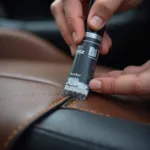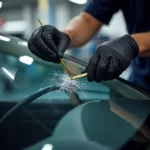Car seat padding plays a crucial role in providing comfort and support during those long drives. Over time, the padding can wear down, become compressed, or even tear, resulting in an uncomfortable and unsightly seat. But don’t worry! This article will explore the ins and outs of car seat padding repair, providing you with all the information you need to know.
Understanding Car Seat Padding
Before we delve into the repair process, let’s understand the different components of car seat padding. Typically, car seats consist of four main layers:
- Frame: The metal structure that provides support and shape to the seat.
- Springs or Webbing: These components offer suspension and absorb shocks.
- Padding: Usually made of foam, this layer provides cushioning and comfort.
- Upholstery: The fabric covering that adds aesthetics and protects the padding.
Common Car Seat Padding Problems
Car seat padding can encounter various issues, including:
- Compression: Over time, the foam padding can lose its resilience and become compressed, leading to a lack of support and discomfort.
- Tears and Rips: Sharp objects, rough use, or even normal wear and tear can cause tears and rips in the padding.
- Sagging: Weakened springs or webbing can result in sagging padding, making the seat uneven and uncomfortable.
- Fading and Discoloration: Exposure to sunlight and regular use can cause the padding’s color to fade or become discolored.
Can You Repair Car Seat Padding?
The answer is, yes, in many cases, car seat padding can be repaired! The feasibility of repair depends on the extent and type of damage.
Minor issues like small tears, compressions, or minor sagging can often be addressed with DIY repair kits or by experienced upholstery shops. These repairs may involve patching tears, adding extra foam for support, or tightening sagging springs.
However, significant damage like large tears, severely compressed padding, or broken frames might require professional intervention or even complete seat replacement.
DIY vs. Professional Repair
Choosing between a DIY approach and hiring a professional depends on your skill level, the severity of the damage, and your budget.
DIY Repair:
- Pros: Cost-effective, quicker turnaround time for minor repairs.
- Cons: Requires basic sewing or repair skills, may not be suitable for all types of damage, and results may vary.
If you’re a hands-on individual and the damage is minor, DIY repair kits can be a cost-effective solution. However, if you’re unsure about your skills or dealing with extensive damage, it’s best to seek professional help.
Professional Repair:
- Pros: High-quality repairs, expertise in handling various types of damage, and access to specialized tools and materials.
- Cons: Can be more expensive than DIY, may require a longer turnaround time.
Professional upholstery shops have experienced technicians who specialize in car seat repairs. They can address a wide range of issues, ensuring a long-lasting and professional finish.
Tips for Maintaining Your Car Seat Padding
Prevention is always better than cure! Here are some tips to maintain your car seat padding and prolong its lifespan:
- Use Seat Covers: Seat covers act as a protective barrier against spills, dirt, and UV rays.
- Regular Cleaning: Vacuum your seats regularly to prevent dirt and debris from settling into the padding.
- Address Spills Immediately: Clean up spills as soon as they occur to prevent staining and damage to the padding.
- Avoid Eating or Drinking in the Car: This minimizes the risk of spills and stains.
- Park in the Shade: Whenever possible, park your car in the shade to protect the interior from prolonged sun exposure.
Conclusion
Maintaining the comfort and appearance of your car seats is essential. While some car seat padding issues can be tackled with DIY solutions, seeking professional help is recommended for significant damage. Remember, regular maintenance and prompt repairs can go a long way in extending the life of your car seat padding and ensuring a comfortable ride.
FAQs about Car Seat Padding Repair
Can I use regular fabric glue to repair a tear in my car seat padding?
It’s best to avoid using regular fabric glue as it may not hold up well to the heat and pressure experienced in a car. Opt for a specialized upholstery adhesive designed for automotive applications.
How much does it typically cost to have a car seat padding repaired professionally?
The cost varies depending on the severity of the damage, the type of repair needed, and the location of the upholstery shop. On average, expect to pay anywhere between $50 to $300 or more for professional car seat padding repair.
Can I replace just the padding in my car seat, or do I need to replace the entire seat?
In many cases, you can replace just the padding without replacing the entire seat. Upholstery shops can often source replacement padding that matches your car’s make and model.
What type of foam is typically used for car seat padding?
Car seat padding typically utilizes high-density polyurethane foam (HDPE) due to its durability, comfort, and ability to retain its shape over time.
Can I reupholster my car seats myself?
Reupholstering car seats is a complex process that requires specialized skills and tools. It’s generally recommended to leave this task to professional upholsterers for the best results.
Need expert advice on repairing your car seat padding? Don’t hesitate to contact us via WhatsApp at +1(641)206-8880 or email us at [email protected]. Our dedicated team is available 24/7 to assist you with all your car repair needs. You can also find more helpful articles on our website, such as how to repair a torn seam in car seat or can car rear seat squab be repaired. We’re here to help you get back on the road in comfort and style!



